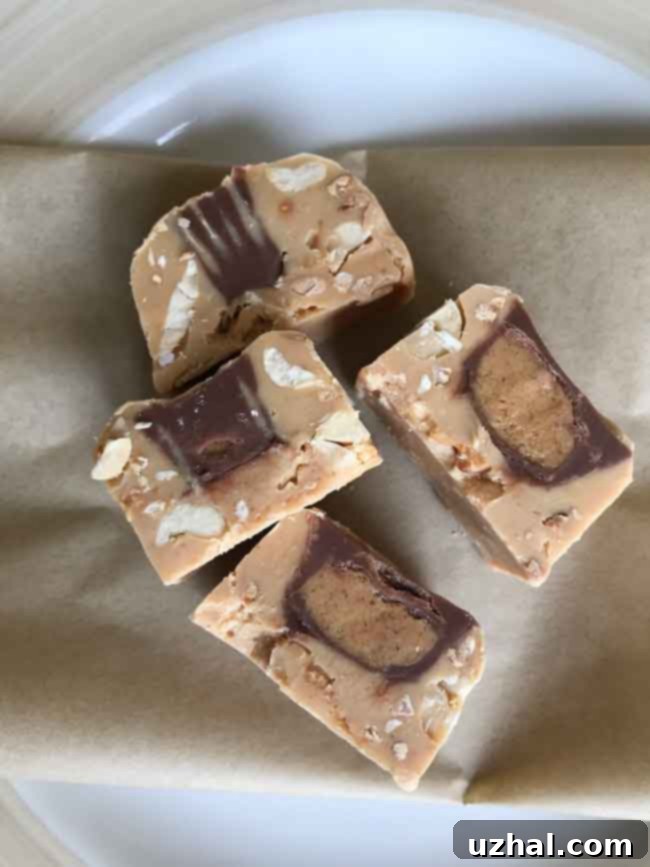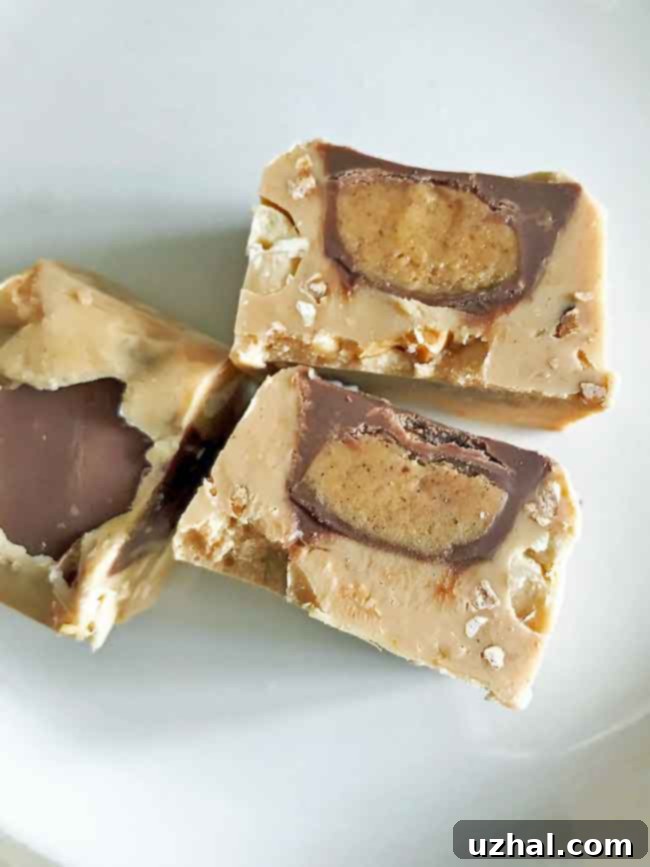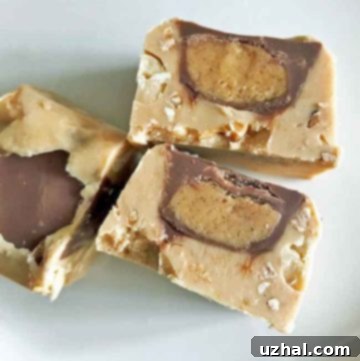The Ultimate Easy Peanut Butter Fudge: Quick & Delicious Homemade Treats
There’s a special kind of joy that comes from whipping up a homemade treat, especially one that’s incredibly simple yet utterly delicious. Peanut butter fudge holds a nostalgic charm for many, a classic confectionery that promises creamy, nutty bliss. While I haven’t accumulated a vast collection of peanut butter fudge recipes over the years, the allure of finding one hailed as “the easiest ever” was simply irresistible. My quest for a straightforward, foolproof method led me to a gem from Taste of Home. This particular recipe caught my eye due to its minimal ingredients and even simpler process: merely melting a pound of white candy coating, stirring in a cup of peanut butter, spreading the mixture into a pan, and chilling until firm. The promise of such effortless creation was enough to get me into the kitchen, eager to test its claims of unparalleled ease.
The beauty of this recipe lies in its approachable nature. Unlike traditional fudge, which often requires a candy thermometer, precise boiling temperatures, and careful stirring, this method bypasses those complexities entirely. It’s a no-fuss, no-fail approach that makes it perfect for beginner bakers, busy parents, or anyone craving a quick sweet fix without a lengthy commitment. The initial process is remarkably swift, demanding only a few minutes of active preparation before the magic happens in the refrigerator. This simplicity, however, comes with its own set of considerations, particularly regarding sweetness and texture, which I soon discovered during my first attempt.
Jump to Recipe

Balancing Sweetness and Enhancing Flavor: My Custom Twists
Upon reviewing the original recipe, a common theme emerged from reviewer feedback: the fudge was often described as excessively sweet. This wasn’t entirely surprising, as white candy coating itself is inherently sugary. Knowing I prefer my sweets with a bit more balance, I decided to take proactive steps to curb the sweetness and introduce additional layers of flavor and texture. My chosen additions were simple but effective: a generous half cup of salted cocktail peanuts and approximately eighteen miniature Reese’s peanut butter cups.
The salted peanuts were a game-changer. Their savory crunch provided a fantastic counterpoint to the sweetness of the candy coating and peanut butter. The salt amplified the natural peanut flavor, creating a more complex and satisfying taste profile. Meanwhile, the miniature Reese’s peanut butter cups brought in an extra layer of rich, creamy peanut butter and a hint of chocolate, further diversifying the flavor and adding delightful chewy pockets within the fudge. These two add-ins truly did the trick, elevating the candy from merely sweet to unexpectedly delightful. The final product was far better than I had anticipated, proving that a little customization can go a long way in perfecting a recipe to your personal taste.

Understanding the Texture: Fudge vs. Candy
While the recipe delivered on its promise of ease and deliciousness, it’s important to manage expectations regarding texture. This particular creation, while delightful, doesn’t quite achieve the characteristic crumbly-yet-creamy texture of traditional, cooked fudge. Instead, it leans more towards a dense, smooth peanut butter candy. The melted candy coating and peanut butter combine to form a solid, melt-in-your-mouth confection that is incredibly rich and satisfying, but distinct from classic fudge.
For those who prefer a more authentic fudge-like texture – one that’s slightly crumbly, incredibly soft, and melts away cleanly – a different type of recipe might be necessary. Traditional fudge often involves cooking sugar, milk, and butter to a specific temperature, then beating it until it crystallizes into that signature texture. If that’s what you’re after, I’ve heard great things about recipes that incorporate condensed milk, marshmallow fluff, or powdered sugar, which can help achieve that classic consistency. Perhaps The World’s Best Peanut Butter Fudge on Allrecipes.com would be a worthwhile next experiment for a truly traditional experience. For now, however, this “easiest” version stands firm as a superb, simple peanut butter candy that is undeniably good and remarkably effortless to prepare.
Choosing Your White Candy Coating: A Key Ingredient
The choice of white candy coating is more critical than one might initially think, as it significantly impacts both the flavor and texture of the final peanut butter fudge. Often referred to as “almond bark” because it’s commonly used to coat nuts for almond bark candy, this product is essentially a confectioner’s coating made from vegetable fats, sugar, and milk solids, rather than cocoa butter. This makes it easier to melt and work with compared to real white chocolate, as it doesn’t require tempering.
I plan to experiment further with different brands, as I believe this is an area where results can vary widely. In the past, I’ve found that some brands, like Wilton Candy Melts, can be a little too sweet for my preference, contributing to the very issue I sought to correct in the original recipe. Actual white chocolate, while delicious, also tends to be very sweet and might introduce a different texture and melting dynamic. Many culinary enthusiasts recommend Mercken’s for its superior flavor and smooth texture, but it, too, might err on the side of extreme sweetness for some applications. So far, my best results have been achieved with Signature Select brand candy coating, which typically comes in a brick format and is often available at grocery chains like Albertson’s or Jewel. Other reliable options include Log House, as well as store brands from Wal-Mart and Target, which also come in bricks and are frequently marketed as almond bark. When selecting your coating, consider factors like ingredient list (some contain more desirable fats than others), reviews for flavor, and how easily they melt. A good quality coating will melt smoothly and blend seamlessly with the peanut butter, contributing to that desirable rich consistency.
Beyond the primary ingredients, the versatility of this easy fudge recipe allows for numerous customizations. Think about stirring in a handful of mini chocolate chips for a peanut butter chocolate swirl effect, or adding a sprinkle of flaky sea salt on top before chilling for an extra gourmet touch. Pretzels could introduce a salty crunch, or you could experiment with different types of nuts, like chopped cashews or pecans, for varied flavor profiles. For festive occasions, consider adding a few drops of food coloring or incorporating sprinkles. The simplicity of the base recipe makes it an excellent canvas for culinary creativity, ensuring that you can adapt it to suit any preference or occasion.
The ease of preparation also makes this peanut butter fudge an excellent gift idea. Imagine a beautifully packaged box of homemade fudge squares, perhaps nestled in colorful paper liners, presented to friends, family, or colleagues. It’s a thoughtful, delicious, and budget-friendly present that conveys warmth and effort without requiring hours in the kitchen. For holiday parties, potlucks, or simply as a comforting treat for yourself, this recipe is a reliable go-to that consistently delivers satisfying results.
Proper storage is key to maintaining the freshness and texture of your peanut butter fudge. Once cut into squares, store the fudge in an airtight container at room temperature for up to a week, or in the refrigerator for extended freshness, up to two weeks. If you choose to refrigerate, allow the fudge to come to room temperature for a few minutes before serving to achieve the best texture. For longer storage, tightly wrap individual pieces or blocks of fudge in plastic wrap and freeze for up to three months. Thaw in the refrigerator overnight before serving.
This easy peanut butter fudge recipe proves that you don’t need to be a seasoned candy maker to create something truly special. It’s a testament to the power of simple ingredients combined in a clever way, yielding a treat that’s comforting, adaptable, and wonderfully indulgent. Whether you’re making it for a special occasion, a quick dessert, or just to satisfy a sudden craving, this recipe is sure to become a cherished addition to your culinary repertoire.
Here’s the recipe:
- Chocolate Covered Marshmallow Cookies
- Holiday Chocolate Truffles
- Chocolate Fudge Pie
- Candy Corn Oreos Halloween Cookie Bark
- Peanut Butter Fudge Brownies
Recipe

Easiest Peanut Butter Fudge
Pin Recipe
Ingredients
- 1 pound white candy coating or almond bark
- 1 cup peanut butter 250 grams
- ½ cup cocktail peanuts salted
- 18 Miniature Reese’s Peanut Butter Cups
Instructions
-
Line an 8-inch or 9-inch square pan with parchment paper or nonstick foil, ensuring some overhang to easily lift the fudge later.
-
Chop the white candy coating (or almond bark) into smaller pieces to facilitate even melting. Place the chopped coating in a large, heavy-bottomed saucepan. Melt over medium-low heat, stirring constantly with a rubber spatula or spoon to prevent scorching and ensure a smooth consistency.
-
Once the candy coating is completely melted and smooth, remove the saucepan from the heat. Stir in the peanut butter and the salted cocktail peanuts until well combined. The mixture should be thick and uniform.
-
Pour about half of the peanut butter mixture into the prepared pan and spread it evenly to form a thin base layer. Arrange the 18 miniature Reese’s peanut butter cups over this layer. Then, pour the remaining peanut butter fudge mixture over the Reese’s and gently smooth the top with your spatula.
-
Chill the pan in the refrigerator for at least one hour, or until the fudge is completely firm and set. Once firm, use the parchment paper overhang to lift the fudge from the pan. Place it on a cutting board and cut into desired squares. Enjoy!
